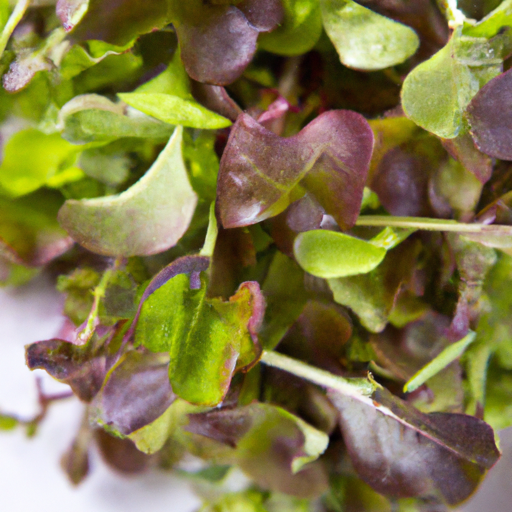Mesclun: A Delicious Medley of Greens
If you are a fan of fresh, vibrant salad greens, then you must acquaint yourself with mesclun. This delightful mixture of young, tender leaves offers an explosion of flavors and textures that will elevate your salads to new heights. In today’s blog post, we will delve deeper into the world of mesclun, exploring its taste, common culinary uses, nutritional benefits, and a touch of its intriguing history.
Taste Sensation
Mesclun is like a symphony for your taste buds. It combines an assortment of diverse greens, each contributing its unique flavor profile. From mild to slightly spicy, the taste range varies from peppery mustard to nutty arugula, and from delicate baby lettuces to the slightly bitter chicory. When these greens are blended together, they create a harmonious balance that is both refreshing and complex.
A Versatile Ingredient
Mesclun is an incredibly versatile ingredient that can be used in a variety of culinary creations. While it shines in salads, it can also be incorporated into sandwiches, wraps, and even stirred into soups at the last minute to add a burst of freshness. Its delicate leaves make it a perfect accompaniment to seafood, poultry, or grilled vegetables. Mesclun truly knows no bounds and can be enjoyed in countless ways.
Nutritional Powerhouse
Beyond its remarkable flavors, mesclun is also a nutritional powerhouse. Packed with dietary fiber, vitamins, and minerals, it provides a robust nutritional profile. Mesclun is especially high in vitamins A and C, both of which are essential for maintaining a strong immune system and healthy skin. It also contains significant amounts of iron, potassium, and calcium, which are vital for various bodily functions.
A Glimpse into Mesclun’s History
Mesclun’s fascinating history can be traced back to the Provence region in France. Traditionally, it was a blend of tender, young greens and herbs that were foraged from the countryside. The word “mesclun” itself is derived from the Provençal word “mescla,” meaning “mixture.” Farmers would carefully select different leaves and herbs to create a unique blend that reflected the flavors of the season. Today, the concept of mesclun has expanded, and commercial blends often include a wider array of greens.
Fun Facts about Mesclun
- Mesclun was popularized in the 1970s by chefs and food enthusiasts looking for a more diverse and adventurous salad experience.
- Mesclun is commonly made up of lettuce, arugula, spinach, mizuna, mustard greens, endive, and radicchio, but the blend can vary depending on the region and preference of the farmer or chef.
- Growing mesclun at home is a fantastic way to enjoy fresh greens all year round. You can easily grow it in containers or small garden beds.
In conclusion, mesclun is a true gem in the culinary world, offering an explosion of flavors, versatility in the kitchen, nutritional benefits, and intriguing historical roots. So, why not experiment with this delightful blend of greens and elevate your salads to new heights? Happy cooking!
Note: While mesclun is generally safe to consume, it is essential to wash it thoroughly before use to remove any dirt or possible contaminants.
Mesclun
- Mesclun is a mix of young salad greens and herbs, typically grown from a variety of different plants. It originated in Provence, France.
- The name “mesclun” comes from the Provençal word “mescla,” which means “mixture.”
- Traditional mesclun typically includes a combination of lettuces, such as oak leaf, curly endive, and arugula, as well as herbs like chervil and dandelion greens.
- The exact composition of mesclun can vary, as it often includes different leafy greens like spinach, Belgian endive, radichio, and mizuna, resulting in a diverse mix of flavors, textures, and colors.
- Mesclun is often harvested when the leaves are young and tender, making it ideal for salads and garnishes.
- This mixed green salad blend gained popularity in the United States in the 1980s and has since become widely available in supermarkets and farmers’ markets.
- Mesclun is versatile and can be enjoyed both raw or cooked. It is commonly used in salads, but can also be added to sandwiches, stir-fries, or used as a bed for grilled meats or seafood.
- Nutritionally, mesclun is a rich source of vitamins A, C, and K. It also contains minerals like iron and calcium.
- The varied combination of greens in mesclun provides a wide range of beneficial phytonutrients, such as antioxidants and anti-inflammatory compounds.
- Mesclun is often associated with “baby greens” due to its tender leaves and vibrant flavor.
- Historically, mesclun was traditionally foraged by farmers who would collect wild greens from their fields and surrounding areas to create their own mixtures.




Use the share button below if you liked it.
It makes me smile, when I see it.